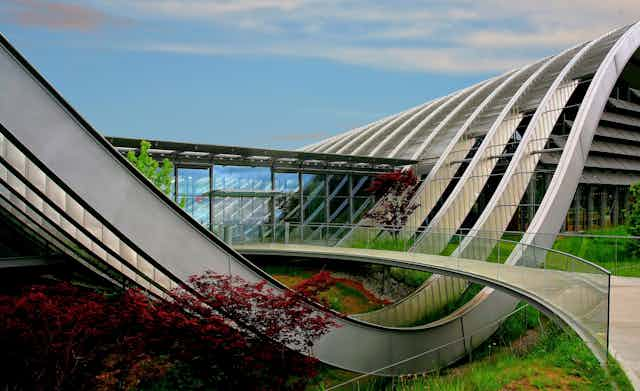Think about where you spend most of your day – home, your office, or university. How does this space make you feel? What do you love (or hate) about it?
Our buildings can help or hinder our health and productivity. For example, we can be affected by daylight access, air quality, connection to nature and acoustics. Most complaints about a space – about temperature, noise, odd smells or even how exposed we feel – relate to these factors.
“Human-centred design” and “healthy” buildings are the latest buzzwords in built environment. Human-centred design is not a new concept; it is why products like smartphones are intuitive, designed around a seamless user experience.
But if you google architectural images, the people (the users) are nearly always missing. A specialist photographer explained this quite frankly to me:
People are not what wins the awards.
Users aren’t at the centre when we design buildings and infrastructure. So are we wasting millions on aesthetically pleasing but useless legacy buildings?
Further reading: Inside out: why do so many great buildings have drab interiors?
A focus on users will become more important as the science on healthy physical environments becomes mainstream. People are more informed than ever before on built environment impacts on their health.
Look outside the premium office space
Initiatives like WELL Building are taking hold at the premium end of the office market. But we mustn’t forget about other sectors, such as schools, universities, aged care, residential and low-grade offices.
For example, universities own and occupy large portfolios of buildings. In Australia, they spent A$10.6 billion on property in the three years from 2011 to 2013.
Employing more than 100,000 staff, with more than 1.4 million students enrolled, how do they know if investments in their buildings actually deliver positive impact for their people?
From linear to closed loop
A key hurdle is the linear nature of the building process. After construction, we rarely go back and gauge if buildings are working well.
This requires some form of post-occupancy evaluation, used frequently in academic research but rarely in practice. Often a “performance gap” exists, because buildings operate differently in real life compared to their design on paper.
Reasons for not checking back are generally associated with cost and with contractors having moved on to another job. Nobody wants to hear what is wrong with a completed building – it means someone has to be held accountable.
When it comes to the users, what if the temperature is uncomfortable? Or it is too noisy? Or people get headaches because of poor ventilation and work elsewhere?
Here are a few comments from a post-occupancy evaluation of a new building:
Lots of daylighting, but it results in glare so the blinds are down most of the time.
The lighting controls are a mystery … don’t stay on and sensors don’t seem to work.
I really like the open plan but we need more privacy.
It’s hard to concentrate on high-level tasks, very noisy.
Weird smell in the morning (from carpets).
Without this feedback, how do we improve our current and future buildings?
Humans aren’t logical
What attracts you to one space but repels you from another?
Often we assume what users need from a space, and this isn’t always correct.
Staying with the university example, student experience is a priority for institutions. It’s measured through rankings such as the Australia Quality in Learning and Teaching (QILT) survey.
In QILT, “learning resources” (teaching and learning spaces, common spaces, labs and libraries) rate relatively well, all above 70% satisfaction (a side note – this is a very general rating). However, satisfaction drops in all these spaces in the last year of study.
Digging deeper in “learner engagement”, ratings are lower: 46% on “interactions with students outside study requirements”, 52% on “interactions with students very different to themselves” and 52% on “sense of belonging to the university”. Overall, international students give only a 28% rating for learner engagement (compared to domestic students’ 66%).
I have seen many buildings where students seem isolated, and QILT shows health and stress is the top reason students consider leaving university.
Can spaces promote better care and connection?
Further reading: Build me up: how architecture can affect emotions
Let design be user-driven
Beyond simple comfort parameters, in a university we have to consider cultural differences (especially if trying to attract a mix of international students), amenity requirements, study needs, disability issues etc in campus design.
The University of Adelaide student hub is an interesting example of human-centred “sticky” design. Students co-created the space with the university. A full-time manager with a customer service background now looks after it, continually tweaking the highly flexible space to suit student needs.
Trends influence design for buildings. Taking successful designs from one industry and applying these directly to another expecting the same outcomes is lazy. It might look nice, but does it suit user needs? Is it healthy and functional?
To reap the benefits of human-centred design we need an industry that honestly values feedback and learning from existing spaces. The numbers on disengaged workforce and sick leave costs – $33 billion per year in Australia – are staggering. We can, and must, do more in all our buildings to curb these costs and create a healthy future.
Further reading: Why the million-dollar view is bad for our body and our soul

